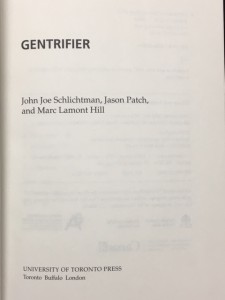 Mary Louise Mossy Christovich and Roulhac Bunkley Toledano explore New Orleans’ French gardens in Garden Legacy. Christovich and Toledano discuss “the history of settlement, battles with the natural world, plant exchanges, politics, [and] economics…all [of which are]…pertinent to understanding a forgotten world of New Orleans gardens and landscape design” (pg. 8). Making use of archival drawings and other primary sources, the authors discover and embrace the essential Frenchness of New Orleans culture and the importance of gardens in the city’s history.
Mary Louise Mossy Christovich and Roulhac Bunkley Toledano explore New Orleans’ French gardens in Garden Legacy. Christovich and Toledano discuss “the history of settlement, battles with the natural world, plant exchanges, politics, [and] economics…all [of which are]…pertinent to understanding a forgotten world of New Orleans gardens and landscape design” (pg. 8). Making use of archival drawings and other primary sources, the authors discover and embrace the essential Frenchness of New Orleans culture and the importance of gardens in the city’s history.
Garden Legacy uses records and documents in The Historic New Orleans Collection to piece together the gardens around New Orleans and provide detailed descriptions. Christovich and Toledano use specific mansions, properties, and plantations as examples that together illuminate what these gardens would have looked like. For example, in the case of the Lombard Plantation, a drawing by Joseph Antoine Pueyo, a well-known artist, “captured the essence of a petit early nineteenth-century French landscape” through his drawing of the Lombard plantation (pg. 141). In the drawing are fruit trees, crepe myrtles, evergreens, and unknown flowers that are visible in many drawings of the era and seem to be typical of French gardens. In the architectural plans, the gardens are not visible, so the authors used the drawings to create a fuller image of the Lombard Plantation. The property is still in existence and has gone through a major restoration to preserve the house and to recreate the gardens as best as possible. These gardens were meant display the wealth of the plantation owners, much like the home they built, and to represent their French roots. Additionally, the the garden featured berry bushes, sixteen different kinds, in fact. There were “citrus and pomegranates…, muscadine grapes, along with raspberries and blackberries…in front of the kitchen house,” providing easy access (pg. 141). Every example in Garden Legacy, of which there are many, features similar fascinating information about properties in and around New Orleans.
Christovich and Toledano have successfully made a strong case for the importance of French gardens in early New Orleans. Garden Legacy is truly exemplary historical work because of the authors’ significant efforts in carefully researching the gardens, sometimes having to use numerous sources to recreate gardens in a meaningful way. The French remain well-known for their gardens – the gardens at Versailles are a major attraction when tourists visit the palace – but New Orleans, despite its French roots, is not associated in any way with beautiful gardens. Garden Legacy changes that. While New Orleans is today a city filled with diverse influences and a great deal of cultural mixing, early New Orleans was distinctly French. These gardens demonstrate how some aspects of French influence were retained while others, such as the gardens, were quickly forgotten. As one of the most famous and important cities in the American South, New Orleans is a city of music, food, tradition, and culture. Christovich and Toledano have recovered an essential part of its early French culture by examining the city’s lost French gardens, capturing the essential Frenchness of a city of many cultures.


 the life of its author, Helen Hunt Jackson. A well-known author of the Nineteenth Century, Jackson’s most famous work remains her novel, Ramona, a fictionalized telling of Native American life in the 1800s, focusing on United States government’s poor treatment of Native Americans and the racial prejudice faced by mixed race individuals. Jackson also wrote A Century of Dishonor, a carefully researched book which revealed how the federal government reneged on treaties and promises made with tribes. She became a leading advocate for better treatment of Native Americans, and was even hired by the Interior Department to visit Missions in California and write a report on the conditions of the “Mission Indians” who lived there, a trip which inspired Glimpses of California & The Missions. This book was written somewhat concurrently with Ramona and the two books make similar arguments about the poor treatment of Native Americans, but are entirely different genres. Yet Ramona was far more widely read than Glimpses of California & The Missions, and the novel has drawn comparisons with Harriet Beacher Stowe’s Uncle Tom’s Cabin for its use of fiction to portray harsh realities and unveil injustices.
the life of its author, Helen Hunt Jackson. A well-known author of the Nineteenth Century, Jackson’s most famous work remains her novel, Ramona, a fictionalized telling of Native American life in the 1800s, focusing on United States government’s poor treatment of Native Americans and the racial prejudice faced by mixed race individuals. Jackson also wrote A Century of Dishonor, a carefully researched book which revealed how the federal government reneged on treaties and promises made with tribes. She became a leading advocate for better treatment of Native Americans, and was even hired by the Interior Department to visit Missions in California and write a report on the conditions of the “Mission Indians” who lived there, a trip which inspired Glimpses of California & The Missions. This book was written somewhat concurrently with Ramona and the two books make similar arguments about the poor treatment of Native Americans, but are entirely different genres. Yet Ramona was far more widely read than Glimpses of California & The Missions, and the novel has drawn comparisons with Harriet Beacher Stowe’s Uncle Tom’s Cabin for its use of fiction to portray harsh realities and unveil injustices.